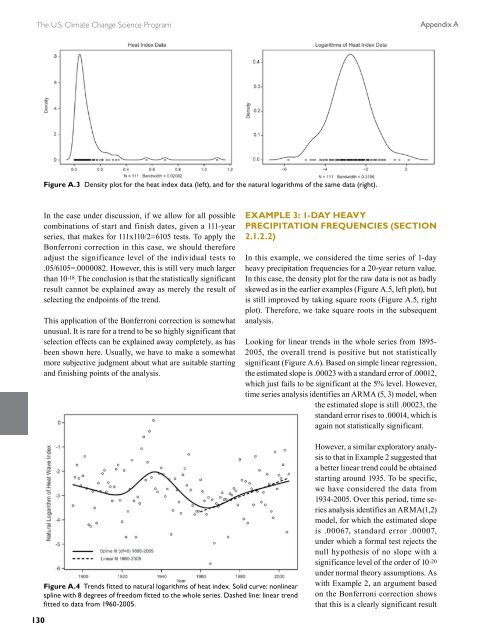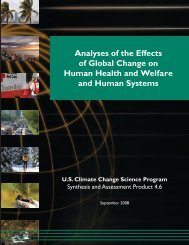Weather and Climate Extremes in a Changing Climate. Regions of ...
Weather and Climate Extremes in a Changing Climate. Regions of ...
Weather and Climate Extremes in a Changing Climate. Regions of ...
You also want an ePaper? Increase the reach of your titles
YUMPU automatically turns print PDFs into web optimized ePapers that Google loves.
The U.S. <strong>Climate</strong> Change Science Program Appendix A<br />
130<br />
Figure A.3 Density plot for the heat <strong>in</strong>dex data (left), <strong>and</strong> for the natural logarithms <strong>of</strong> the same data (right).<br />
In the case under discussion, if we allow for all possible<br />
comb<strong>in</strong>ations <strong>of</strong> start <strong>and</strong> f<strong>in</strong>ish dates, given a 111-year<br />
series, that makes for 111x110/2=6105 tests. To apply the<br />
Bonferroni correction <strong>in</strong> this case, we should therefore<br />
adjust the significance level <strong>of</strong> the <strong>in</strong>dividual tests to<br />
.05/6105=.0000082. However, this is still very much larger<br />
than 10 -18 . The conclusion is that the statistically significant<br />
result cannot be expla<strong>in</strong>ed away as merely the result <strong>of</strong><br />
select<strong>in</strong>g the endpo<strong>in</strong>ts <strong>of</strong> the trend.<br />
This application <strong>of</strong> the Bonferroni correction is somewhat<br />
unusual. It is rare for a trend to be so highly significant that<br />
selection effects can be expla<strong>in</strong>ed away completely, as has<br />
been shown here. Usually, we have to make a somewhat<br />
more subjective judgment about what are suitable start<strong>in</strong>g<br />
<strong>and</strong> f<strong>in</strong>ish<strong>in</strong>g po<strong>in</strong>ts <strong>of</strong> the analysis.<br />
Figure A.4 Trends fitted to natural logarithms <strong>of</strong> heat <strong>in</strong>dex. Solid curve: nonl<strong>in</strong>ear<br />
spl<strong>in</strong>e with 8 degrees <strong>of</strong> freedom fitted to the whole series. Dashed l<strong>in</strong>e: l<strong>in</strong>ear trend<br />
fitted to data from 1960-2005.<br />
ExAMPlE 3: 1-DAY hEAVY<br />
PRECIPITATION fREqUENCIES (SECTION<br />
2.1.2.2)<br />
In this example, we considered the time series <strong>of</strong> 1-day<br />
heavy precipitation frequencies for a 20-year return value.<br />
In this case, the density plot for the raw data is not as badly<br />
skewed as <strong>in</strong> the earlier examples (Figure A.5, left plot), but<br />
is still improved by tak<strong>in</strong>g square roots (Figure A.5, right<br />
plot). Therefore, we take square roots <strong>in</strong> the subsequent<br />
analysis.<br />
Look<strong>in</strong>g for l<strong>in</strong>ear trends <strong>in</strong> the whole series from 1895-<br />
2005, the overall trend is positive but not statistically<br />
significant (Figure A.6). Based on simple l<strong>in</strong>ear regression,<br />
the estimated slope is .00023 with a st<strong>and</strong>ard error <strong>of</strong> .00012,<br />
which just fails to be significant at the 5% level. However,<br />
time series analysis identifies an ARMA (5, 3) model, when<br />
the estimated slope is still .00023, the<br />
st<strong>and</strong>ard error rises to .00014, which is<br />
aga<strong>in</strong> not statistically significant.<br />
However, a similar exploratory analysis<br />
to that <strong>in</strong> Example 2 suggested that<br />
a better l<strong>in</strong>ear trend could be obta<strong>in</strong>ed<br />
start<strong>in</strong>g around 1935. To be specific,<br />
we have considered the data from<br />
1934-2005. Over this period, time series<br />
analysis identifies an ARMA(1,2)<br />
model, for which the estimated slope<br />
is .00067, st<strong>and</strong>ard error .00007,<br />
under which a formal test rejects the<br />
null hypothesis <strong>of</strong> no slope with a<br />
significance level <strong>of</strong> the order <strong>of</strong> 10 -20<br />
under normal theory assumptions. As<br />
with Example 2, an argument based<br />
on the Bonferroni correction shows<br />
that this is a clearly significant result




